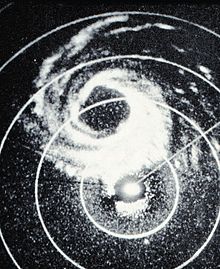 A radar image of Hurricane Alice north of the Virgin Islands | |
| Meteorological history | |
|---|---|
| Formed | December 30, 1954 |
| Dissipated | January 6, 1955 |
| Category 1 hurricane | |
| 1-minute sustained (SSHWS/NWS) | |
| Highest winds | 90 mph (150 km/h) |
| Lowest pressure | 980 mbar (hPa); 28.94 inHg |
| Overall effects | |
| Fatalities | None |
| Damage | $623,000 (1954 USD) |
| Areas affected | Lesser Antilles |
| IBTrACS | |
Part of the 1954 Atlantic hurricane season | |
Hurricane Alice is the only known Atlantic hurricane to span two calendar years and one of only two named Atlantic tropical cyclones, along with Tropical Storm Zeta of 2005, to do so. The twelfth tropical cyclone and the eighth hurricane of the 1954 Atlantic hurricane season, Alice developed on December 30, 1954, from a trough of low pressure in the central Atlantic Ocean in an area of unusually favorable conditions. The storm moved southwestward and gradually strengthened to reach hurricane status. After passing through the Leeward Islands on January 2, 1955, Alice reached peak winds of 90 mph (140 km/h) before encountering cold air and turning to the southeast. It dissipated on January 6 over the southeastern Caribbean Sea.
Alice produced heavy rainfall and moderately strong winds across several islands along its path. Saba and Anguilla were affected the most, with total damage amounting to $623,500 in 1955 USD (greater than $6,500,000 in 2022 USD). There was an earlier hurricane named Alice in the season. Operationally, lack of definitive data prevented the U.S. Weather Bureau from declaring the system a hurricane until January 2. It received the name Alice in early 1955, though re-analysis of the data supported extending its track to the previous year, resulting in two tropical cyclones of the same name in one season.